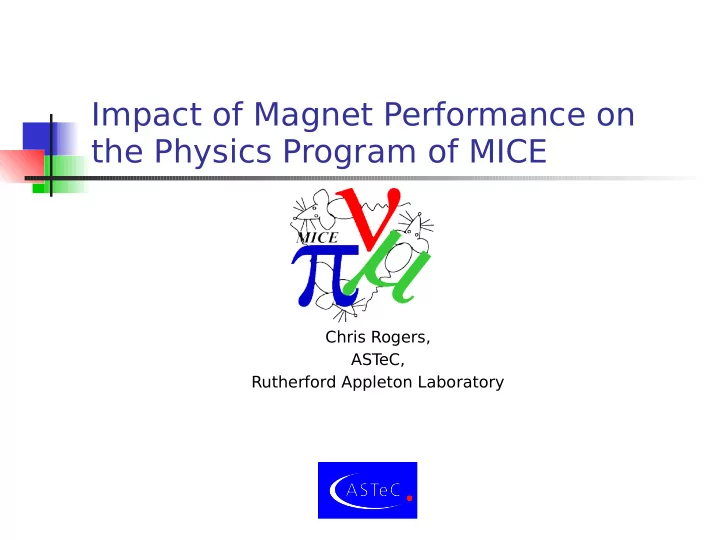

Impact of Magnet Performance on the Physics Program of MICE Chris Rogers, AST eC, Rutherford Appleton Laboratory
Overview Focus Coil 1 has not reached specified currents Non-flip mode → specified currents reached Flip mode → stuck at around 200 MeV/c required current Even here, need an operating overhead of order 10% If FC can't be fixed; how does this limit the performance of Step IV? What about Step VI? Caveat: All of this is linear optics Great for getting an idea of the parameter space Not sufficient for redefining MICE baseline
Step IV Step IV has just FC, no coupling coil and no lattice What beta function can be achieved with reduced FC current? Coils End coils and Centre coil is fixed for 4 T field on tracker Optimise for matching using Match 2 and Match 1 Vary focus coil and look at response
Beta function matching Standard setting at Step IV is that beta should be symmetric about absorber (z=0) Require dbeta/dz = 0 at the absorber centre Choose dbeta/dz = 0 in the constant solenoid field (analytic solution here) Example for 200 MeV/c E2, Centre, E1 set for 4 T M2 set to max current 148.09 A/mm 2 M1 varied for matching FC current at nominal 113.95 A/mm 2
Solutions to Match Condition In some cases, there is more than one solution to the match condition for a given M2 current e.g. at 140 MeV/c case to right Means we need to be careful about applying optimisation routines Want to find all the possible match conditions...
Scaling M2 Fix M2 and let M1 vary freely to find a match As before, scan to find all possible solutions Then optimise to get the best match See two families of solutions for p = 140 MeV/c
Matching vs Momentum Range of available optics for a given focus coil strength Nominal + 20% (“Best”) Nominal – 10% (“Actual”)
Step IV - Conclusions Reduced FC current limits accessible range of beta functions Assume FC performance as FC 1 e.g. J < 102 A/mm 2 with 10 % operating margin Minimum beta function 32 mm → 104 mm at 140 MeV/c Minimum beta function 136 mm → 224 mm at 200 MeV/c Minimum beta function 215 mm → 356 mm at 240 MeV/c Can still achieve “nominal” beta function (420 mm) Some exotic options are ruled out in flip mode Maximum beta function is unaffected Prefer low FC current for large beta functions
Step VI Consider now Step VI SFoFo lattice only Assume we can match (but see discussion above) Look at how optics scales with Coupling Coil and Focus Coil currents Repeat over 5500 mm cell length in flip mode
Nominal magnets, 200 MeV/c By way of example Bz as a function of z Beta function for a half cell What is momentum dependence of beta function? At focus (absorber) At anti-focus (scraping aperture)
Response to FC – 200 MeV/c MICE operates in 2 pi → 4 pi phase advance region Fills the momentum acceptance Interested in beta and stop bands Assume FC performance as FC 1 e.g. J < 102 A/mm 2 with 10 % operating margin Stop bands unmoved Beta function 420 -> 500 mm Equilibrium emittance increases by ~ 20% (proportional to beta)
Response to FC – 240 MeV/c Scale lattice by increasing currents by 20 % Assume FC performance as FC 1 Beta function ~ 50-100% higher Equilibrium emittance ~ 50-100 % higher Bigger chromatic aberations Weaker (2pi) resonance Possibly slightly better acceptance Beta at midpoint is lower How do these optics scale with CC current?
Response to FC current Overview Something Something else And more
Response to FC current Overview Something Something else And more
Response to FC current Overview Something Something else And more
Conclusions MICE is still operable with reduced FC Quite robust to poor performing magnets But physics performance is slightly reduced Lose low beta function options at Step IV Poor 240 MeV/c performance at Step VI Caveat: All of this is linear optics Great for getting an idea of the parameter space Not sufficient for redefining MICE baseline Further details in MICE Note 434 http://mice.iit.edu/micenotes/public/pdf/MICE0434/MICE0434.pdf
Recommend
More recommend